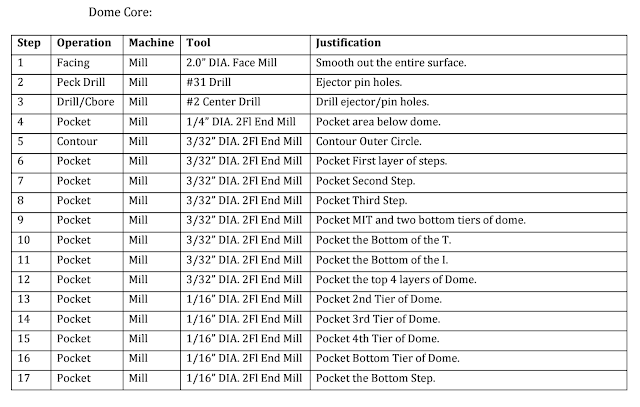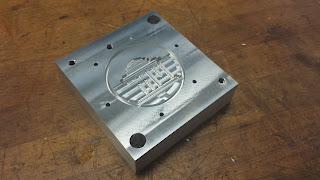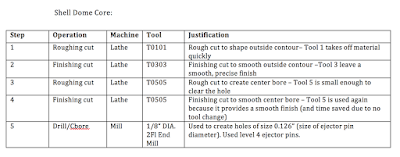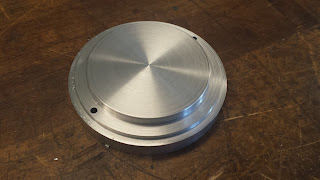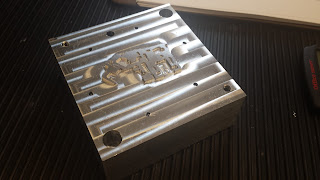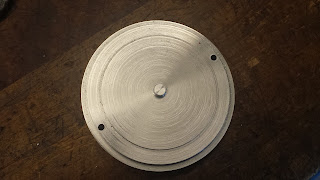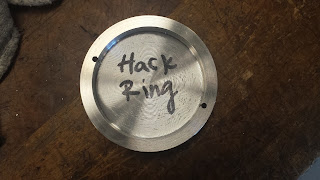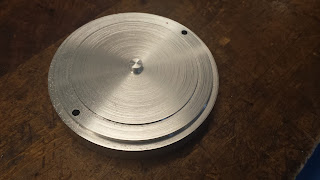Dome Optimization:
 |
| Figure 1: First production of injection molded dome with clear defects. |
 |
| Figure 2: Left to right: Process of optimization and noticeable disappearance of hole. |
 |
| Figure 3: Optimized injection molded dome with no defects. |
Process plan for Dome Cavity mold
Process plan for Dome Core mold
Map Optimization:
The map was originally too large to snap into the body shell. To fix this, we remade the cavity mold to have a smaller OD in order to allow for the snap fit with the measured shrinkage tolerances taken into account. The injection molding parameters were optimized, and can be seen in the set up sheet below.
Injection Hold
| |||||
Injection Hold Pressure Profile: P7-P16
| |||||
1000
|
1000
|
1000
|
1000
|
1000
| |
1000
|
1000
|
1000
|
1000
|
1000
| |
Injection Hold Time
|
8.0 s
| ||||
Cooling Time
|
25.0 s
| ||||
Set Screw Feed Stroke (Shot Size)
|
2.2 in
| ||||
Injection Boost
| |||||
Injection Speed Profile: V12-V21
| |||||
4.5
|
5.0
|
5.5
|
5.0
|
4.0
| |
4.0
|
4.0
|
3.0
|
2.0
|
1.5
| |
Injection Boost Pressure
|
1500 Psi
| ||||
Screw Feeding
| |||||
Screw Feed Delay Time
|
2.0 s
| ||||
Ejector
| |||||
Ejector Counter
|
2
| ||||
1/8” Ejectors Pins Length
|
5.570
| ||||
¼” Ejector Pin Length
|
#2
| ||||
 |
| Optimized injection molded Hack Map. |
Body Shell Optimization:
There was only one iteration for the mold that makes the body of the yo-yo. Several body shells were injection molded using this mold. We inspected all of them and saw that they were consistently without blemishes of any sort (short shots, flashes, etc). The snap fits of the hack map and the dome were individually modified to fir the snap fits set in the body shell. Therefore, the original settings resulted in optimal body shells for our yo-yo.
Injection Hold
| |||||
Injection Hold Pressure Profile: P7-P16
| |||||
400
|
400
|
400
|
400
|
400
| |
400
|
400
|
400
|
400
|
400
| |
Injection Hold Time
|
8.0 s
| ||||
Cooling Time
|
20.0 s
| ||||
Set Screw Feed Stroke (Shot Size)
|
2.2 in
| ||||
Injection Boost
| |||||
Injection Speed Profile: V12-V21
| |||||
3.5
|
4.0
|
4.5
|
4.0
|
3.0
| |
3.0
|
3.0
|
2.0
|
1.0
|
0.5
| |
Injection Boost Pressure
|
801 Psi
| ||||
Intrusion Speed
|
100 in/s
| ||||
Screw Feeding
| |||||
Screw Feed Delay Time
|
2.0 s
| ||||
Ejector
| |||||
Ejector Counter
|
2
| ||||
1/8” Ejectors Pins Length
|
5.460
| ||||
¼” Ejector Pin Length
|
#2
| ||||
 |
| Optimized injection molded Hack Map/Dome Shell. |
Thermoform Optimization:
 |
| Optimized thermoformed Dome Cover. |

